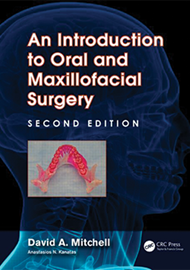An Introduction to Oral and Maxillofacial Surgery is a book of two parts. This is described in the book as basic patient care and oral surgery. It is a surprisingly comprehensive book considering the volume of material it covers, with an extremely tall order of covering the modern and expanding speciality of oral and maxillofacial surgery in 440 pages.
Clearly it cannot be used as an all-encompassing reference text but it gives a very useful overview of the panacea of pathologies and subsequent treatments encountered in oral and maxillofacial surgery.
The first half is adequate with all the basics a senior house officer or dental foundation trainee in oral and maxillofacial surgery would want to know, when encountering ward work in a hospital for the first time. Much of this would not be needed for a medically qualified trainee.
Chapters are laid out in an easy to read format with clear objectives at the start followed by a logical journey from the history and examination through to the investigation and final management of the conditions concerned. The authors have gone to great lengths to include pictures and diagrams where possible, which supplement the text very well.
The basic oral surgery section is excellent with good clinical photographs and the relevant information written well and concisely. The sections on getting involved in research and how to get into the speciality were particularly useful for the new modern trainees; these topics are often not covered in other clinical oral and maxillofacial textbooks.
I understand the notion of trying to appeal to a wider audience in Western Europe and North America but really this book is aimed at the UK trainee. The sections that outline differences in approach to management across the world are interesting but probably not that useful in everyday practice. The sections on details covering German and US practice, although illuminating, lack detail and give the impression that these additions have been made to increase circulation overseas. I believe these populations are already served by texts in their respective regions.
This book is aimed at the keen undergraduate and postgraduate in either dentistry or medicine undertaking their second degree. It would also be most useful for those in core surgical training or those gearing up to apply for higher specialist training and perhaps for those in the first year ST3 specialist training.
Overall, I think this is an excellent introduction to oral and maxillofacial surgery for anyone with a little experience in the field. The basic patient care section is basic but does include considerable amounts of information in a relatively short section.
This book comes into its own in the chapters on oral and maxillofacial surgery with excellent photographs and clear objectives at the beginnings of chapters. The sections on getting into oral and maxillofacial surgery and how to start writing a paper are particularly useful for the target audience. The author should be commended on the vast information they have managed to satisfactorily include in a book this size encompassing basic oral surgery, maxillofacial trauma, cleft lip and palate, oncology surgery and much more. This book is a useful addition for oral and maxillofacial trainees transitioning into higher specialist training.





